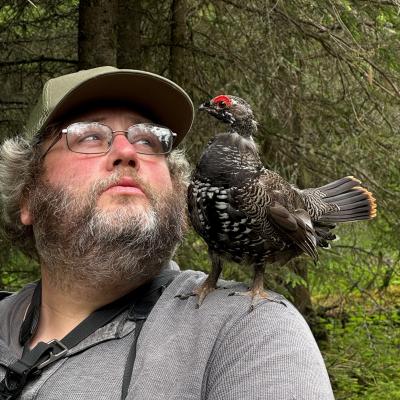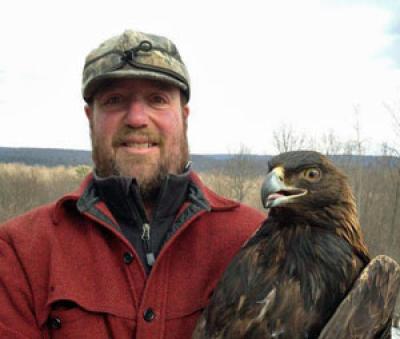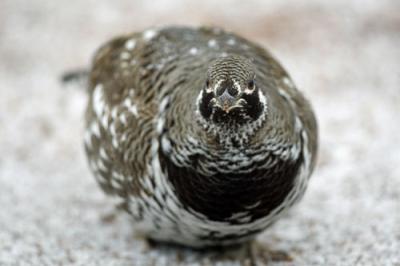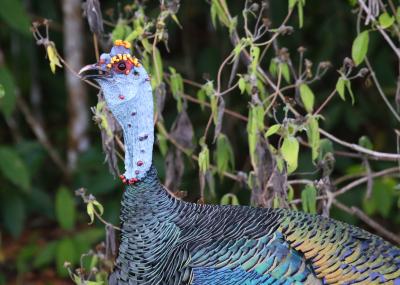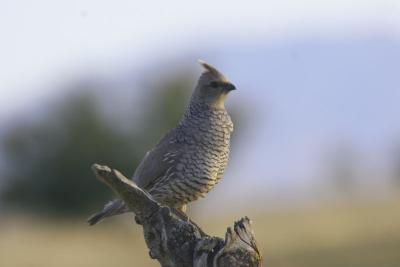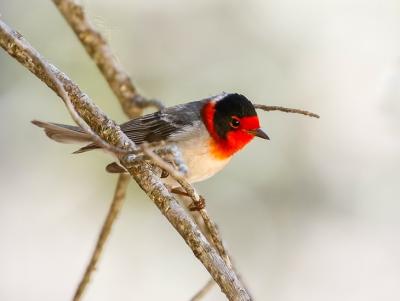Colorado: Lekking Grouse
-
Apr 2-12, 2026
Skye Haas and Frank Nicoletti
-
Apr 2027
Skye Haas
2026
Single Room Supplement $870
2027
Tour Price to be Determined
2026
Single Room Supplement $870
2027
Tour Price to be Determined
April is a spectacular time of year in Colorado. Late winter and early spring combine stunningly beautiful snowcapped peaks with the first blush of green on the river-edge cottonwoods and prairies. It’s also the time when the five lekking grouse species—Sharp-tailed Grouse, Greater and Gunnison Sage-Grouse, and Lesser and Greater Prairie-Chickens—are engaged in their amazing foot-stomping, cackling, hooting, and/or moaning displays.
Our travels to the grouse leks involve long drives, but what drives! We’ll travel along the Colorado River and the magnificent Black Canyon of the Gunnison, through montane spruce-fir forests and expansive sagebrush flats and grasslands, and past more than a dozen 14,000-foot mountain peaks. Along the way we’ll look for a variety of resident, early-arriving, or late-departing species, including White-tailed Ptarmigan, Dusky Grouse, and all three species of rosy-finch. Mammals will be unusually well represented too: we may see Bighorn Sheep, Pronghorn, Elk, White-tailed and Mule Deer, Moose, Coyote, Red Fox, and, with great luck, Bobcat or even Mountain Lion.
Day 1: The tour begins at 6:00 p.m. at our hotel near Denver International Airport. Night in Denver.
Day 2: We’ll depart early for the foothills outside Denver, where we may see three species of nuthatch, Mountain and Western Bluebirds, and Williamson’s Sapsucker. If the weather cooperates, we’ll make our way to one of the high mountain passes in an attempt to locate the difficult-to-find White-tailed Ptarmigan, still white at this season. During some years rosy-finches linger into April, and occasionally we’re lucky enough to see all three species. In the afternoon we’ll have a few hours’ drive through spectacular mountain scenery before crossing Monarch Pass and dropping into Gunnison. Night in Gunnison.
Day 3: For our first grouse morning we’ll visit a lek of Gunnison Sage-Grouse. This highly localized bird was only recognized as a full species in 2000, and visits to the lek site are strictly regulated. We’ll absorb the ritual dance-displays of these wild looking grouse, and then we’ll head west out of Gunnison to the breathtaking Black Canyon of the Gunnison National Park, where we’ll search for Dusky Grouse, Fox Sparrow, and others. Along the way we’ll pass the Blue Mesa Reservoir, which could harbor Barrow’s Goldeneye and other waterfowl. Night in Gunnison.
Day 4: If we haven’t encountered rosy-finches yet, we’ll head up to nearby Crested Butte where all three species can be found. From there we’ll meander our way east through the mountains, enjoying majestic scenery and stopping to look for Pinyon Jay, Clark’s Nutcracker, American Three-toed Woodpecker, Williamson’s Sapsucker, and others. We’ll then arrive to the Canon City area in search of arid-loving species such as Juniper Titmouse and Rufous-crowned Sparrow. Night in Canon City.
Day 5: We’ll continue the next morning in our explorations of the dry brushlands looking for Scaled Quail, Canyon Towhee, Canyon Wren, and Curve-billed Thrasher before starting a long drive for Kansas. We’ll take a few stops along the way looking for Clark’s and Western Grebes and huge numbers of migrating waterfowl, while impromptu stops could yield migrating Mountain Plover, flocks of Chihuahuan Ravens, or interesting raptors. Night in Hays, Kansas.
Day 6: This morning we will visit a blind for Lesser Prairie-Chicken, a species that has undergone dramatic population declines across its already limited range. We’ll arrive early to the blinds and observe these handsome birds court while being serenaded by Western Meadowlarks. We’ll make our way north for the afternoon enjoying spring unfolding on the prairies. Night in McCook, Nebraska.
Day 7: Thanks to the help of the Red Willow County Visitors Bureau in McCook, we’ll witness sunrise at a Greater Prairie-Chicken lek. We’ll likely hear the eerie calls that accompany the magnificent dance of this species even before we can make them out in the dim light, with the tinkling of Horned Larks in the dark sky above. After the birds have finished displaying, we’ll head west for Fort Collins, taking a short birding break in the renowned and expansive prairies of Pawnee National Grasslands. Night in Fort Collins.
Day 8: We’ll have a flexible morning to look for any rarities in the Fort Collins area before we start to work our way over the mountains to Cameron Pass; we could even return to the Pawnee Grasslands if birding conditions are favorable. Rock Wren, Pygmy Nuthatch, Northern Pygmy-Owl, and American Three-toed Woodpecker are some of the birds we may see along the very scenic drive. Any feeders on the west side of the pass will be our afternoon goal, with rosy-finches, Pine Grosbeak, and Cassin’s Finch all possible. In the mid-afternoon we’ll make the drive to our hotel in Walden. Night in Walden.
Day 9: We’ll rise early to witness the extraordinary display of the largest North American grouse, Greater Sage-Grouse. As we watch the lek, we’ll pay particular attention to the plumage and behavior that distinguish this species from Gunnison Sage-Grouse we observed at the start of the tour. After leaving the lek, we’ll spend the rest of the day exploring the nearby wetlands and sagebrush flats of North Park, where Sage Thrashers might already be in residence. We may see the courtship of newly arrived Cinnamon Teal and American Avocet, and perhaps lingering winter birds like Rough-legged Hawk and Northern Shrike. We’ll also look for Moose as Walden is reputed to be the Moose capital of Colorado. Wolves are also known to be in North Park. Night in Steamboat Springs.
Day 10: We’ll have an early start to search for Sharp-tailed Grouse, one of the more difficult of the “chickens” on this tour. With some luck we’ll witness the wonderful foot-stomping display of this species. If the weather conditions will allow for it, we’ll may want to make another attempt for White-tailed Ptarmigan and any remaining rosy-finches we may still need. Because early spring weather in Colorado can be unpredictable, we may be unable to reach the snowy, high-elevation ptarmigan country; in that event, we’ll spend one last afternoon birding the foothill forests or some of the many fine reservoirs or migrant traps along Colorado’s Front Range. We’ll make our way southeast, arriving in Denver in the late afternoon. Night in Denver.
Day 11: The tour concludes this morning in Denver.
Note: The information presented below has been extracted from our formal General Information for this tour. It covers topics we feel potential registrants may wish to consider before booking space. The complete General Information for this tour will be sent to all tour registrants and of course supplemental information, if needed, is available from the WINGS office.
ENTERING THE UNITED STATES: Non-U.S. citizens will need a valid passport and may need a tourist visa or visa waiver. Please consult your nearest U.S. Embassy or consulate for details. Canadian citizens need to carry proof of citizenship in the form of a passport.
COUNTRY INFORMATION: You can review the U.S. Department of State Country Specific Travel Information here: https://travel.state.gov/content/travel.html. Review foreign travel advice from the UK government here: https://www.gov.uk/foreign-travel-advice and travel advice and advisories from the Government of Canada here: https://travel.gc.ca/travelling/advisories.
PACE OF THE TOUR: This tour involves several early mornings (with 4:30am starts), as viewing the display leks requires waking about two hours BEFORE sunrise for a quick breakfast and a drive to the lek. We’ll view the leks from the van or from controlled blinds and everyone will need to be relatively still and quiet for about two hours. During this time, the van must stay at the lek and people will NOT be able to get out. All of this is essential to reduce disturbance to the birds.
After viewing the birds, we’ll return to the hotel to gather luggage (and a more complete breakfast) and then head toward the next destination, birding along the way. Typically, a day’s driving will total about 225 miles, sometimes on windy mountain roads. These drives will be broken by several birding stops, restroom breaks, etc. Walking will usually be on well-maintained trails or along roads, and will be less than a half mile in duration. We will endeavor to have between 45 and 60 minutes off each day before dinner, but most of the day will be spent in the field.
If the weather cooperates and roads are open, we’ll look for White-tailed Ptarmigan on the first full day. This could involve a short walk on steep and snowy terrain, at an elevation of 12000 feet. People will have the option of staying in the vans.
HEALTH: Colorado has no serious health risks other than altitude.
Altitude: Starting on the first full day of the tour, we’ll be driving up to the highpoint of the tour, just above 12,000 feet. From this point we merely scan from a stationary position, but we may walk a short distance in snowy conditions. Otherwise we’ll be at altitudes from 3000 to 8000 feet throughout. The best defense is to stay hydrated and wear the right clothes (layers) for warmth.
Smoking: Smoking is prohibited in the vehicles or when the group is gathered for meals, checklists, etc. If you are sharing a room with a nonsmoker, please do not smoke in the room. If you smoke in the field, do so well away and downwind from the group. If any location where the group is gathered has a stricter policy than the WINGS policy, that stricter policy will prevail.
CLIMATE: April is a dynamic time of year in Colorado and nearly every type of weather is possible, from heavy snow to clear blue sky and mid-70s (F). It is possible for it to be 70ºF, sunny and calm, only for the temperature to plummet to around 20ºF with heavy snowfall, all in a period of two or three hours! You will need to be prepared for a wide range of weather conditions. Typical highs range in the 50s and 60s (F), with lows in the upper 20s and low 30s (F). Lows in the single digits (F) are rare, but not impossible. Early mornings spent at leks may be particularly cold. Snow is likely; Denver averages about nine inches for all of April. Rain and snow is possible at anytime. Given this, it is very important to dress in layers (see notes below).
ACCOMMODATIONS: We will be staying at standard, comfortable motels and/or lodges throughout the tour. As of 2023 most of our hotels offer free wifi access.
FOOD: We’ll eat in a variety of local restaurants where the food will in most cases be American standard. Some examples include an Italian restaurant in Denver, steakhouse in Gunnison, and Mexican restaurant in Craig, though the quality of Indian restaurants in the high mountains can surprise! Breakfasts are generally taken in our hotels (continental plus), and lunches will be in local or chain sandwich stores or cafes.
WINGS tours are all-inclusive and no refunds can be issued for any tour meals participants choose to skip.
Food Allergies / Requirements: We cannot guarantee that all food allergies can be accommodated at every destination. Participants with significant food allergies or special dietary requirements should bring appropriate foods with them for those times when their needs cannot be met. Announced meal times are always approximate depending on how the day unfolds. Participants who need to eat according to a fixed schedule should bring supplemental food. Please contact the WINGS office if you have any questions.
TRANSPORTATION: We will be traveling by leader-driven 15 [or 12] passenger window van or minivan, depending on the group size. When using 15-passenger window vans, we will take a maximum of seven passengers plus the leader/driver. Participants should be able to ride in any seat in tour vehicles and will be expected to change seats daily.
2025 Narrative
IN BRIEF: Ah, the spring dancing chicken tour, a modern-day quintessential Americana experience. From the wind-swept prairies to gorgeous sky-touching mountains, this tour is a feast of experiences that include stunning scenery, charming rural villages, charismatic megafauna and of course, some of the most elaborate breeding displays seen in North American birding. The 2025 tour had a host of highlights including 22 species of waterfowl including Greater White-fronted Goose and Barrow’s Goldeneye, Mountain Plover and Long-billed Curlew, American Goshawk, Ferruginous Hawk, Lewis’s and Three-toed Woodpeckers, all three Rosy-finches and a full sweep of all the lekking grouse species! We had an incredible mammal list too, 3 species of Prairie Dog, Pronghorn, Bighorn Sheep, Bison, Elk, Black Bear and even a trio of Moose!
IN DETAIL: I’ve been running this tour for a few years now, and this was without a doubt, the best run I’ve had yet. The weather was great, the birds and mammals were incredibly cooperative and Frank and I were treated to a remarkable group of participants that all did their best to help make this ramble across the heart of the American west a fantastic adventure. We met this merry cast of travelers in the mile-high city of Denver where we got to know each other over an introductory meet-and-greet dinner. The following morning we awoke to a chilly start, even a touch of snow flurries were dancing about, but this ended up being our coldest morning of the entire tour, a welcome respite on a tour that can toss some wintery weather at times. We started our birding at the nearby Rocky Mountain Arsenal National Wildlife Refuge. Here we had a nice selection of waterfowl, as well as some Horned and Western Grebes. The refuge is also notable for hosting a herd of Bison, an exciting remnant of the western prairies.
This first day is a big travel day though so we kept it moving and left the Denver area behind and headed up the front range of the Rocky Mountains. We first went up to Loveland Pass to look for White-tailed Ptarmigan; sadly this was one of our few misses of the tour, but it was thrilling to crest 12k and look down from the top of the world! We stopped in Wildernest for some lunch, and afterwards we rolled around a fir coated neighborhood to a set of feeders that had a flock of Brown-Capped Rosy-Finches. Within their numbers we were able to pluck out a handful of Gray-Crowned and Black Rosy Finches. Numerous other mountain species were present such as Pine and Evening Grosbeaks, Mountain Chickadees and the always lovely Cassin’s Finch. Again, we had to tear ourselves away so we would have time to make one final stop in the town of Buena Vista to look for a most glamorous bird, a wintering Lewis’s Woodpecker. As if it was anticipating our time crunch, the bird flew up the moment we stepped out of the vans! Of course, we couldn’t just tick and run for such a glorious looking bird, and our devoted attention actually attracted quite the crowd of the local neighbors who were delighted to get scope looks at this beautiful creature. So not only a great bird for our tour, but a great moment in outreach! After such a success, the group settled in to complete the long and beautiful drive to the mountain town of Gunnison, where we would make our base for the next two days.
For our first day of birding, Gunnison, we had a reasonable rise time and breakfast to counter the previous long day, and then headed up a nearby mountain river canyon to look for forest birds. Right out the gate, a perched Golden Eagle was sighted at the top of a canyon wall, allowing for a lengthy study. Equally delightful were a pair of American Dippers bobbing along in the river. As we headed further up the canyon, new birds popped up for us, Townsend’s Solitaire, Pygmy Nuthatch, Red Crossbill, Mountain Bluebirds. And then we encountered our prize for the morning, an adult male American Three-toed Woodpecker! This bird performed for the group, and everyone got fantastic looks! We then started to head up the mountain to the ski-town of Crested Butte to try to see if we could get a second helping of Rosy-Finches. A bit of driving around the neighborhoods paid off as it had before, and we found a few flocks of Rosy-Finches. Most were the expected species of Brown-capped, but we also plucked out a couple of Gray-crowned Rosy’s. We then broke to return to Gunnison for lunch and a little bit of a break, and then headed back out for some late afternoon birding. We worked Cottonwood riparian flats, and looked at a reservoir, and rolled around on the sage brush hills. We had more Golden Eagles, a flyby Prairie Falcon, and a Great Horned Owl incubating on a nest.
The following day was our first lek day! We got up early and headed out to a willow flat where a modified trailer had been set up so we could witness the ancient ritual of the endangered Gunnison Sage-Grouse gathering and display to attract a mate. Due to their endangered status, precautions are high for these birds, and the blind is distant from the actual lek. Still, it is thrilling to see these birds with their spiky tails strutting around. With a scope one can see the longer flowing black crest that separates the species from its look-alike Greater Sage-Grouse. As the sun got higher over the sagebrush clad hills, the grouse slowly departed and eventually it was ok to leave the blind and head back to town for a well-earned hearty breakfast! Afterwards, we packed up our gear, and started to work our way off the Gunnison Plateau. Along the way we picked up a few great new species in the form of Clark’s Nutcracker and Rough-legged Hawk. We then cruised over the Monarch Pass and dropped back down in a warm valley where we spent the rest of the afternoon birding. Here among the Ponderosa Pines we found Bushtits, Pink-sided Juncos, and after a bit of searching, a flock of Pinyon Jays! We also noticed a bit of a hawk migration going on, with Bald Eagles and Red-tailed Hawks circling by and we even had an early Swainson’s Hawk. We then stopped at a lake where we had a couple of classy looking waterfowl- some Cinnamon Teal and a pair of Barrow’s Goldeneyes. We then rolled down the Arkansas River through a gorgeous red rock canyon and arrived to Canon City where we would spend the night.
On our fourth day, we awoke near our furthest points south. Here the bird life took on a distinct flavor of the southwestern deserts. We headed down to a region of juniper scrub and rangeland and cruised around finding some of the interesting denizens of this habitat. Notable were the large numbers of Townsend’s Solitaires feasting on the bumper crop of juniper berries. We had a host of other interesting birds here such as Bewick’s Wren, Western Bluebird, Woodhouse’s Scrub-Jay and Juniper Titmouse. We stopped for lunch and then started the long drive to Kansas to get in position for our next lek experience. As we set off across the short grass prairies, we allowed for a few stops, one at a Black-tailed Prairie Dog town where we had several Burrowing Owls co-habitating within the dogtown. A few miles over we had a pair of Mountain Plovers. But the real shocker for the afternoon was pulling right up to a dark morph adult Ferruginous Hawk. This regal beast was stunning and a lifer for most! We then proceeded to finish the long drive to Oakley Kansas for the night.
Day five was an exciting one! We arose early to meet a biologist from Kansas Audubon to witness the displays of the critically endangered Lesser Prairie-Chicken. This species has had an incredibly severe decline in its population and central Kansas may be the last stand for this bird. Thankfully, the woman charged with their recovery is an accomplished researcher as well as advocate for the Prairie-Chickens and it was a real treat to hear the results of her studies on this charming grouse. And charmed we were! Small pop-up tents were erected in the dark and then the group huddled into them where we were treated to a front row seat of these engaging birds. Unlike their larger relatives, the male Lessers perform cooperative displays with birds performing their dances in unison, with delightful little explosive popping sounds. We then loaded up and headed on to McCook Nebraska where we attended a delightful talk on Greater Prairie Chickens and then had a great dinner and early bed for our next day’s lek.
The recovery program for the Greater Prairie-Chicken is thankfully a little more optimistic than that of the Lessers. While they still need unplowed tall-grass prairie, this species is a bit more flexible when it comes to habitat changes and human disturbance. For this lek, we were brought to a private ranch where a long-time rancher has become very devoted to helping protect this species. Settling us into a pair of tricked out livestock trailers, this was a very comfortable way to have a great view of today’s dancing chicken show! Before there was even enough light to see the birds, one could hear their melancholic moaning over the prairie wind. Before long there was enough light to watch the birds begin their dances, a vigorous shuffle punctuated by leaps into the air as they inflated their colored neck air sacs and, unlike the Lessers, got into some pretty rough tumbles with other males. After this fantastic show, we drove back into McCook for breakfast and to check out of our hotel. After checkout, we stopped at a local McCook park, where we nabbed a bunch of birds we wouldn’t get elsewhere, Purple Martins, Red-bellied Woodpeckers, a male Yellow-headed Blackbird, and a flock of geese that had Ross’s, Greater White-fronted and a handful of Cackling Geese with them. We then started the trek back into Colorado. A brief look at a large reservoir gave us a flock of American Avocets. We finished our days birding with a run through Pawnee Grasslands, but had little other than Western Meadowlarks and Horned Larks. Settling down for the night in Fort Collins, Colorado, everyone was ready to fall into bed after a long drive to be fresh for the next day.
We started out our birding tooling around Fort Collins for a couple of hours, looking at some lakes and marshes. We had some nice flocks of ducks, a few more Avocets and a rare treat with a small flock of Long-billed Curlews and White-faced Ibis. From there we then headed up one of my more favorite mountain canyons on this tour, the Poudry River. It was a gorgeous spring day and even though the birding wasn’t particularly noteworthy, everyone enjoyed the gorgeous scenery and the relaxed pace of our travels that day.
On our penultimate day of the tour was another early morning, but like all lek mornings, a thrilling experience to be had! We headed out in the dark and settled onto a dirt road running along a ridge where we would use our own vans as blinds to view the majestic Greater Sage-Grouse. This glorious beast is a near turkey sized grouse with a dramatic spiked tail, and a pair of ochre-colored inflatable chest air sacs. As the males bounce the sacs up and down and strut about the lek, more and more pheasant-like females would creep along the ground, trying to act as nonchalant as they could as they assessed the fitness of potential males. And what a show it was! Truly the best Sage Grouse performance I had seen, the weather was gentle and the birds were running hot!
After the grouse departed the lek, we birded the Walden Reservoir and had a robust flock of several duck species, some American Avocets and a couple new trip birds- California Gull and Long-billed Dowitcher. On the outskirts of the Walden area we were driving past a willow clad stream when someone spotted a Moose! We turned around and one turned into three, providing a rare get for this tour! We then headed out to the town of Steamboat Springs, where we checked in and had an early dinner. On our way back to the hotel, we saw another good tour mammal, a sluggish Black Bear just coming out of hibernation and still shaking off the cobwebs!
For our final day, we had one last dancing grouse to track down. This one would be a little bit of a challenge as leks can shift around from year to year, but after a little searching, we encountered a flock of displaying male Sharp-tailed Grouse up on a ridge. One of my favorite dancers among the grouse, they have quite the flashy set of sets they engage in to entice a female for breeding. After the lek broke apart we rolled around some more in the hills above Steamboat Springs getting some nice looks at Swainson’s Hawk and Golden Eagle and another quick flyby of a Prairie Falcon. Closer to town, we headed up a known birdy canyon for one last round of birding; here we had nice looks at Evening Grosbeaks, and two final new trip birds, good ones too, Red-naped Sapsucker and an American Goshawk! Quite the rocking finish for the trip! Content and happy, we spent the rest of the afternoon driving back to Denver where we had a delicious farewell dinner before finally parting ways from a most excellent tour!
- Skye Haas
Maximum group size seven with one leader or 14 with two leaders.




































